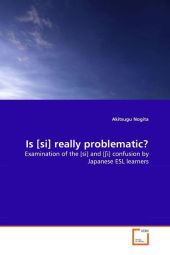 Neuerscheinungen 2010Stand: 2020-01-07 |
Schnellsuche
ISBN/Stichwort/Autor
|
Herderstraße 10
10625 Berlin
Tel.: 030 315 714 16
Fax 030 315 714 14
info@buchspektrum.de |

Akitsugu Nogita
Is [si] really problematic?
Examination of the [si] and [ i] confusion by Japanese ESL learners
2010. 128 S.
Verlag/Jahr: VDM VERLAG DR. MÜLLER 2010
ISBN: 3-639-30496-9 (3639304969)
Neue ISBN: 978-3-639-30496-1 (9783639304961)
Preis und Lieferzeit: Bitte klicken
It is a general belief that the English /si/ and / i/ are problematic for Japanese ESL learners. This study examines whether monolingual Japanese speakers distinguish [si] and [ i] in both perception and production and what are the sources of Japanese ESL learners´ challenges in mastering [si] and [ i]. In the first experiment, 93 monolingual Japanese speakers pronounced [si] and [ i] in the Japanese contexts, and listened to [si] and [ i] recorded by a native speaker of English. The participants all distinguished [si] and [ i] in both perception and production. Based on these results, I hypothesized that the [s] and [ ] confusion by Japanese ESL learners is caused by misunderstanding. In the second experiment, 27 Japanese ESL students were recorded reading an English passage. After the reading the participants were taught the basic symbol-sound correspondence rules such as "s"-/s/ and "sh"- / /. No articulation explanations were given. After the lesson, the participants read the same passage, and they pronounced /s/ and / / significantly more correctly. I concluded that the /s/ and / / confusion can be solved by teaching the English phonics rules without teaching the articulation.
I received a master´s degree in Applied Linguistics from University of Victoria in Canada. My interest is in second language phonology and phonetics, or more specifically, Japanese ESL learners´ phonological awareness and Katakana English interference.


